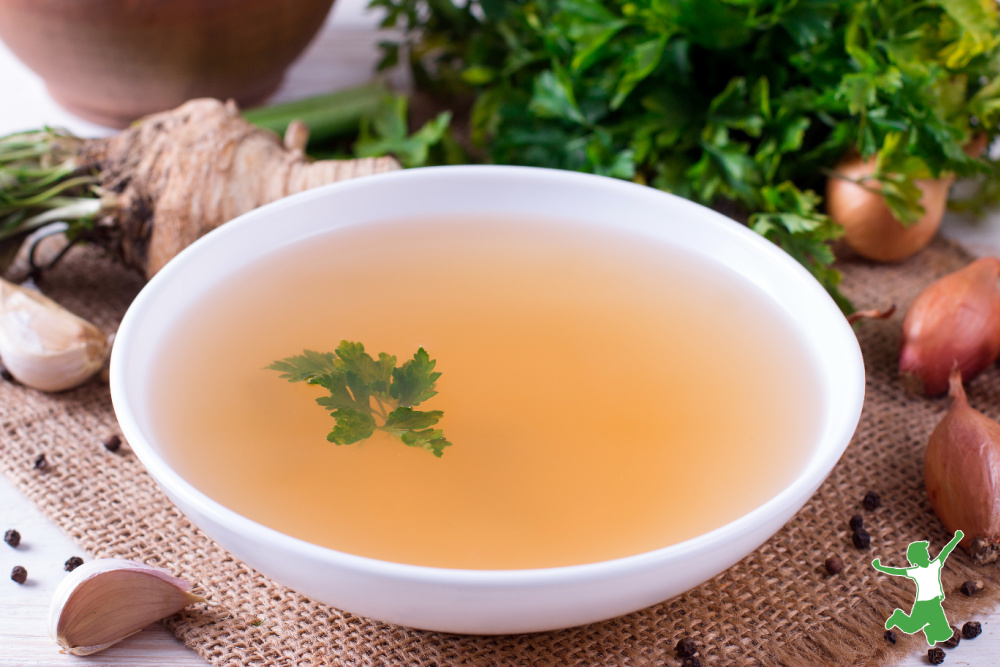How the French art of remouillage makes the most of your real food budget by saving money making bone broth or stock.

The Culinary Arts Dictionary defines the French word remouillage as a weak stock made by resimmering bones that have been used to make bone broth once already.
Indeed, this is exactly what remouillage is: a rewetting or remoistening of soup bones that have already served their purpose with a previous batch of bone broth or stock (not to be confused with meat stock).
It is a frugal approach to using broth bones much like boiling meat is the thiftiest way to cook it on a tight budget.
Despite the fact that my Father’s side of the family is French, I only started practicing remouillage well into the second decade of my traditional foods journey.
Folks had mentioned to me in the past that they “reused soup bones”. At first, this approach seemed to be an example of frugality run amok.
If you’ve simmered bones once, how could resimmering them possibly achieve anything close to the delectable flavor and superior nutrition of first batch?
As it turns out, there is always something new to learn with Traditional Cooking!
Broth from Reused Bones
The second batch of stock made from the same soup bones is definitely weaker than the first.
This is the case even when adding fresh carrots, celery, onions, and a bay leaf or two. Note that it is not advisable to reuse the vegetables from the first batch of stock.
However, you can easily compensate for this by simply boiling the remouillage down until the flavor and color is roughly comparable with the first batch.
The final result yields less stock – about half in my experience. The upside is that you will have more thoroughly made use of your investment in quality soup bones!
What Type of Bones Work for Remouillage?
What types of bones work best when making remouillage?
I’ve used all types of poultry (including chicken feet) and beef bones. All have worked very well and produced excellent results.
I am not in favor of using fish heads for stock more than once. The heads pretty much disintegrate after the first batch, and fish heads are so cheap to buy anyway. I pay $1.50/lb for top quality snapper heads.
Making Stock With the Same Bones More than Twice?
Some cooks claim to use hard bones like beef or buffalo for making stock not once, not twice, but three or more times!
An article by Amanda Rose on The Nourishing Gourmet claims that high gelatin bones called “beef feet” can produce up to 12 batches of gelatinous stock!
How many times should you make remouillage considering that each batch will have less flavor than the previous one?
The choice is totally up to you.
Certainly, when the bones disintegrate is a good sign to stop. This happens with fish heads which are good for only a single batch.
However, if you have beef bones that are still hard and obviously have some minerals left in them after the first couple of batches, then go ahead and make another batch and see what happens.
Best Uses for “Second Batch Bone Broth”
It’s important to keep in mind that you aren’t losing anything by making a second batch of broth with the same bones.
If the stock turns out too weak tasting, simply boil it down. This will concentrate the flavor until it is acceptable to use as a base for your soups, sauces, and gravies.
Other uses for weak, second batch broth include:
- Weak remouillage is perfect for cooking rice or quinoa instead of plain filtered water.
- Use it to make savory soaked oatmeal instead of the typical sweet versions.
- Remouillage makes a tasty base for mashed potatoes.
- Try cooking up your next pot of sourdough pasta in remouillage instead of water.
Are you already a fan of this French art of using bones twice to make broth? If so, please share your experience!









If you are making your second batch immediately after the first batch, I’m curious as to why it’s not advisable to reuse your vegetables from the first batch. I’ve always just left them in there with no problem.
Ever since I’ve started making bone broth I’ve always used the bones twice. No idea that this actually had a name 😀 I usually mix the second broth with some of the first broth and then use is for soups like pumpkin soup or cauliflower soup or Chinese egg drop soup.
I like to make a meat (gelatin) stock first in my VitaClay pot. Then I put the bones back in with the same veggies plus more water and apple cider vinegar to work on a bone broth. The last time I did this with my chicken, I cooked through about three 9 hour cycles on “slow” in the VitaClay. I had a small amount of this broth and I did NOT like the taste and I felt weak and like yuck afterwards. It’s discouraging when something like this happens as it’s hard to determine the issue. I’m buying pasture-raised chicken. The meat (gelatin) stock was delicious. A part of me gets paranoid thinking maybe something is in the clay, but I know the Vitaclay comes highly recommended and has third-party testing to make sure there are no heavy metals in the clay.
Fat goes rancid after 3 hours of boiling. After the first three hours you need to strain the broth, pick out the bones and add back only bones and fresh water water.
The animal fats in broth are heat stable saturated and monounsaturated fats. They are much sturdier than heat unstable polyunsaturated fats.
I’ve had this happen before. I would suggest that perhaps your temperature was too low. There are bacteria that can survive higher temperatures, and the longer you cook something the more they multiply if the heat is not high enough. You must maintain at least a simmer. And even though you start with cold water, get to that simmer as quickly as possible; time spent in the bacterial range is cumulative. Also, nine hours is way too long for something as small as chicken bones.
For years we have made what we call “second-hand broth” to use for soup. We use the “first-hand broth” for soup, too, but also save it for drinking when we want to drink broth plain.
Once you’ve made the first batch of broth, can you freeze the bones for a batch later on?? I would think they shouldn’t be frozen and re-cooked more than once.
That is not advisable. If you are going to make a second batch of broth, it should be done immediately.
I have often used the bones two or three times, then used the resulting light broth to simmer fresh bones in. I feel like I’m getting all the nutrition from the spent bones, and getting a head start on the next batch of broth.
I have cooked stock many times twice. The second batch never thickens. Maybe I need to boil it down more.
I like to can my soups but I feel as though the pressure cooker is destroying the collagen in the stock.
Thank you for the article as I do not like to waste anything and like to see my food go as far as it can.
Whenever I roast protein like pot roast or roast chicken as an entree I don’t discard, I save the bones for stock or soup. I put them in a stock pot along with carrots, onions, celery and wate. My parents have done all their lives, it’s essentially a remouillage.